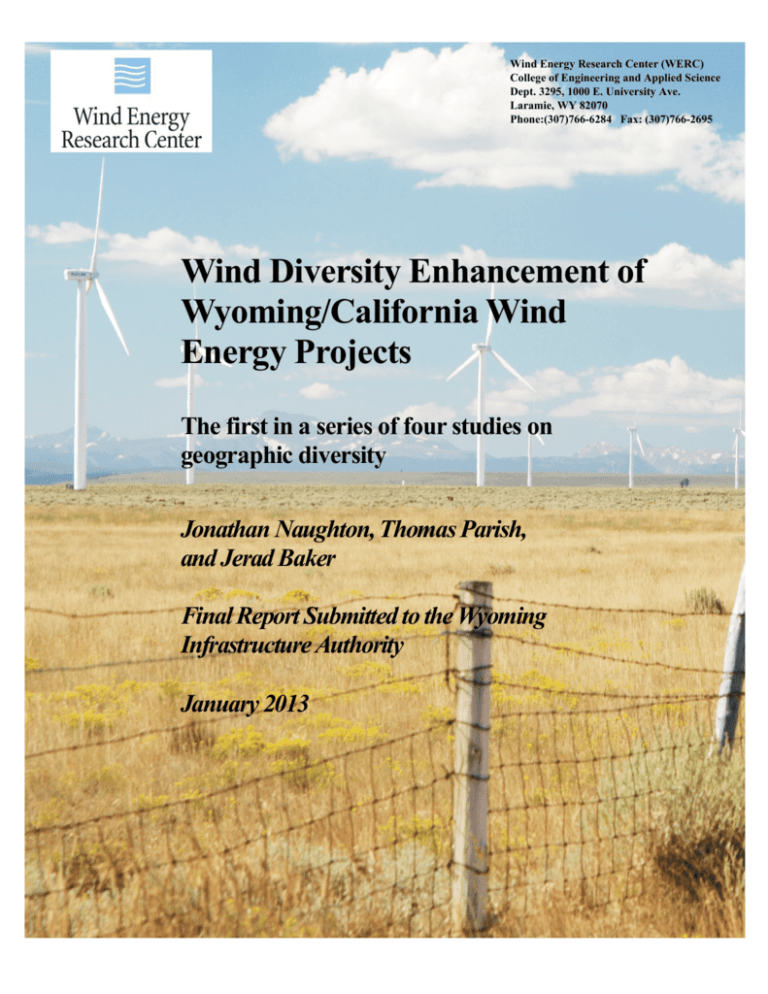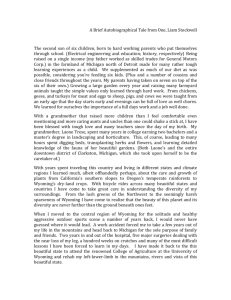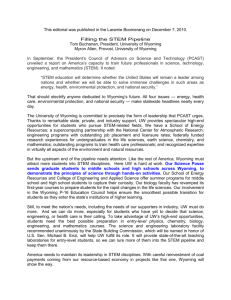
Wind Energy Research Center (WERC)
College of Engineering and Applied Science
Dept. 3295, 1000 E. University Ave.
Laramie, WY 82070
Phone:(307)766-6284 Fax: (307)766-2695
WERC-2012-2
Wind Diversity Enhancement of
Wyoming/California Wind
Energy Projects
.
.
. first.in a series
. of four
. studies
. on
The
geographic diversity
Jonathan Naughton, Thomas Parish,
and Jerad Baker
Final Report Submitted to the Wyoming
Infrastructure Authority
January 2013
.
.
.
The authors of this study would like to acknowledge the financial support provided by the
Wyoming Infrastructure Authority. In addition, the support provided by Loyd Drain, Executive
Director of the Wyoming Infrastructure Authority is gratefully acknowledged.
This document is copyrighted by the University of Wyoming, all rights reserved. © 2013
The U.S. Department of Energy and the State of Wyoming are granted a royalty-free, nonexclusive, unlimited and irrevocable license to reproduce, publish, or other use of this document.
Such parties have the authority to authorize others to use this document for federal and state
government purposes.
Any other redistribution or reproduction of part or all of the contents in any form is prohibited
other than for your personal and non-commercial use. Any reproduction by third parties must
include acknowledgement of the ownership of this material.
You may not, except with our express written permission, distribute or commercially exploit the
content. Nor may you transmit it or store it in any other website or other form of electronic
retrieval system.
This report is the first in a series of four reports to compare the geographic diversity of Wyoming
wind with wind resources
1. in California;
2. in Colorado;
3. in Nebraska; and
4. within Wyoming.
1
Executive Summary
Due to its outstanding wind resources, the economic benefits of developing
Wyoming generated wind power for export to other states have been considered
many times. This report discusses an issue that has not received much attention to
date – the importance of diversity in wind resources. This report specifically
considers the diversity of Wyoming and California wind and the benefits that are
realized in the combination of these two resources. A year of wind resource
predicted by a weather forecasting model is used as input to the analysis. A general
analysis first considers the diversity in large areas of both states, and then specific
locations are investigated to show the benefits of combining the locations predicted
to have both good and diverse resources. These analyses yield the following
important results.
The wind resources in Wyoming and California are complementary in that
the winds are largely uncorrelated due to their large geographic separation.
The diversity of the wind in the two states yields real-world benefits when
specific Wyoming and California sites are combined.
o
Variability of the wind-generated power is reduced thus decreasing
the large swings observed from single installations and simplifying
the integration of wind into the grid.
o
Savings in the $100 million range each year from reduced payments
for dispatchable power could be realized. Assuming the dispatchable
power is from fossil fuels, reduction in greenhouse gases can also be
realized.
o
Wind power from Wyoming can be available at critical times when
California’s wind is not and when the load on the California’s
electrical grid (CAISO) most requires it.
2
Definitions
Cross correlation
A measure of the similarity of the behavior of the
resources at two locations. High values of the cross
correlation can indicate similar behavior, whereas low
values of the correlation can indicate different behavior.
Correlation coefficient
Normalized correlation. The correlation coefficient
varies between 1 (high correlation) to 0 (no correlation).
Diurnal variations
Variation of a resource over a day (hourly variations)
Diversity
Resources that exhibit diversity are complementary.
Resources at sites with little diversity behave similarly
(high at the same time, low at the same time), whereas
good diversity indicates little relationship between
resources at different sites.
Geographical diversity
Diversity that arises from using two resources from
different locations
Gross capacity factor
The amount of power predicted to be produced at a site
(excluding down time and other losses) at a particular
hub height relative to what would be produced were the
turbine running at full output all the time
Hub height
The height of the center of the wind turbine rotor (or the
hub) above ground level
Joint statistics
Statistics that involve two different locations
Makeup power
Alternate power used when wind power falls below what
it is expected to supply
Power curve
The relationship between wind speed and output power
for a specific turbine
Ramping event
Large rapid changes in wind-generated power output due
to rapid increases or decreases in wind speed
Root mean square (rms)
A measure of the variability of power. The root mean
square is equivalent to the standard deviation.
Seasonal variations
Variation of a resource with season
Wind power density
A measure of the wind resource (in Watts per square
meter) at a particular site independent of the wind
turbine to be used
3
Introduction
California is a leader in wind-produced electricity, but is also a large energy user. In
contrast, Wyoming has some of the best wind resources in the world, but is already a
net exporter of electricity. As a result, a number of studies indicate that providing
electricity generated by Wyoming wind to California is beneficial to both States.
Recently, 80m and 100 m wind maps developed by NREL in conjunction with AWS
Truepower indicated that Wyoming has a significant amount of developable wind at
a capacity factor of 45% or greater as shown in Figure 1.1 Currently, the state of
Wyoming has just over 1400 MW of installed wind capacity, and thus the State’s
wind resources can provide for significant expansion. Nine (9) of the Western States
have a need for such resources due to Renewable Portfolio Standards (RPS). For
example, California has a standard that requires their electric utilities to provide 20%
of their retail sales from renewable energy by 2013 growing to 33% in 2020.2 This
alignment of wind resource and need is promising. California’s RPS accounts for
two-thirds of the renewable demand in the Western Interconnect. This alignment of
wind resource and need is promising. A recent Western Electricity Coordinating
Council (WECC) 10-year regional transmission study has indicated that locating
12,000 GWh of electricity production, or
13% of the electricity required under
California’s RPS, in Wyoming would result
in a reduction in the annualized capital cost
of ~$600 million per year.3 The WECC
study analyzed wind development in
California and compared the economics to
the development of wind in Montana, New
Mexico and Wyoming. Wyoming’s high
quality wind resource resulted in the annual
savings referenced above. Such savings over a 20 year period represent a net present
value of over $9 billion dollars assuming a 5% interest rate.
Despite these economic advantages, wind adds the complexity of being a variable
generation source dependent on the temporal variation of the winds. As wind energy
continues to penetrate further into the electricity market, issues such as forecasting
capability, backup generation and eventually grid-scale energy storage become
critical to address. Identifying ways in which to mitigate the cost and to address
operating issues associated with the variability of renewable energy on the grid was
the catalyst that resulted in the commissioning of the current report.
An additional benefit of using resources from different geographical resources is the
potential of reducing the effects of variability in the wind. Swings in electricity
production by renewable resources are known as ramping events. So called wind
diversity can lead to less volatile changes in energy output. At a given location, the
variability of the wind arises from several sources including diurnal and seasonal
variations. Aside from straight statistical measures, issues such as the passing of
weather systems affect the exact temporal variations experienced at a wind site. Thus
using energy produced from several different sites can smooth the variations as these
time-dependent features will not happen at the same time at all sites. The reduction
of ramping events from standalone wind farms can be particularly beneficial to
Regional Transmission Operators (RTO), Balancing Authorities (BA) and the rate
payers.
4
Power Capacity above GCF (GW)
800
600
400
200
0
30
40
50
GCF - Gross Capacity Factor (%)
60
Figure 1 – Wind development potential in Wyoming at various gross capacity factors. A
hub height of 80 m has been assumed. This figure has been adapted from reference 1.
The objective of this work is to perform an initial assessment of the effectiveness of
combining California and Wyoming wind resources. Several sites are chosen for
evaluation in Southeastern Wyoming and throughout California. Wind data at the
sites are considered to quantify wind resource diversity, and demonstrations of the
effectiveness of diversity are provided. The results indicate that, in addition to
providing additional renewable resources, using geographically diverse sites can
significantly decrease variability (i.e. ramping events). Thus, wind diversity is
another benefit of using geographically disperse wind resources that may add to other
benefits (such as cost of energy, resource
availability and development issues) to assist with
decisions on how to obtain the level of renewable
energy desired. Given the proven economic
benefits of Wyoming wind delivered to
California, the diversity of the wind resource
between the states provides additional reasons to
consider combining renewable energy assets to
meet renewable energy targets today and in the future.
Description of Wyoming and California Winds
A brief description of Wyoming and California winds is presented here. Southeast
Wyoming winds are driven by the topography, elevation, and the weather conditions
that result. Flow through the low point in the continental divide caused by pressure
differences that set up across Wyoming in the winter cause that season to have the
best wind resource. However, wind resource remains very good throughout the rest
of the year, with a fairly significant decrease in winds in the late summer. See a
companion report on Wyoming wind diversity for a more detailed discussion of
Wyoming’s wind.4
The wind resource in California is such that the higher quality winds are much more
localized. The historical wind energy development locations are all located in passes
that serve to funnel winds from one side of the mountains to the other. Low winds
are typical of the winter, whereas the warmer weather associated with spring and
summer draws cool coastal air inland toward the interior valleys and deserts.5
5
As is evident, the processes affecting the winds in Wyoming and California are
significantly different, which should provide beneficial diversification should wind
plants at multiple sites in Wyoming be used to provide power
for California. In addition, capacity factors exceeding 45%
are expected at new installations located in Wyoming,
whereas historical capacity factors at the better locations in
California are in the 25-30% range.6 These California
capacity factors include both newer and older turbines, so it is
not necessarily representative of the capacity factors that
could be expected from new installations. Studies also
suggest that technology improvements that increase net
capacity factor for turbines operating in lower wind regimes
will also increase the net capacity factors in windier areas by
an equivalent amount.
Approach
Overview
To investigate the promise of wind diversity on wind energy power production, an
initial investigation using data from a mesoscale weather forecasting model is carried
out. One year of data for multiple sites in Wyoming and California is used. Monthly
average wind speeds are investigated to characterize overall trends, whereas
correlations between sites are used to estimate diversity. Finally, power production
from a distribution of turbines over different combination of sites is determined.
While not comprehensive in nature, these analyses clearly support the importance of
wind diversification.
Locations Chosen
For this initial study, five locations in the wind
producing areas in Southeastern Wyoming were selected
for the analysis: sites near Rawlins (RSW), Casper
(CNE), Medicine Bow (MBW), Southern Laramie
Valley (LVS), and Wheatland/Chugwater (WC). These
locations, shown in Figure 2, are regions of favorable
wind resource near current wind plants or those
proposed for development in the future. In California, three primary sites that are
homes to current wind plants, Tehachapi Pass (TP), San Gorgonio Pass (SGP), and
Altamont Pass (AP), were chosen for this analysis and are also shown in Figure 2.
Description of Data Sets
The data used for these studies were obtained from the Weather Research Forecast
Model (WRF) run with a High Resolution Window (HRW) that provides 4 km
horizontal spacing. The closest grid point in these data sets to the points identified in
Figure 2 was used to provide wind information. The data used here were extracted
from one of four WRF runs performed each day, and data were taken from the model
for 24 hours past the start time. The next day’s simulations were then used to
continue the data from that point. One year of data was used starting in July 1, 2009
extending until June 30, 2010. For some periods of heavy forecasting use (e.g. the
month of August), the solutions did not exist due to the need to use computational
resources for other purposes (e.g. Hurricane modeling). Data extracted from the
model were used to estimate hourly wind speeds at 80 m above the ground.
6
Figure 2- Wind sites selected for the Wyoming/California wind diversification study.
Analysis Performed
Several types of analysis were performed here to evaluate wind diversity. First the
annual wind power densities (the average of the instantaneous wind power density
, where is the density and is the instantaneous velocity at the height
1/2
of interest) at 80 m above ground level were determined to locate likely sites for
development and to provide an evaluation of the wind resource at locations of
existing wind sites. Next, correlations were performed between specific sites in one
state with sites in the region of interest in the other state. Using site pairs with
promising correlations, monthly and diurnal wind speeds and power production
estimates were all used to demonstrate the benefits of diversity. Determination of
correlations and power production is discussed in more detail below.
Joint statistics between sites is the primary means used to quantify diversity. For this
purpose, scatter plots of the wind power density at two locations were first
considered. Such plots graphically depict the relationship between the winds at
different times. To quantify this relationship, the cross correlation of the wind power
density between the two sites
was calculated using
∑
,
and a corresponding cross correlation coefficient
/
7
was defined here as
/
,
where p1 and p2 are the wind power density at the different sites identified by x1 and
x2, and N is the number of wind power densities that are used in the determination of
R. The first equation is equivalent to the cross-correlation function at zero time lag
as defined in reference 7. When the correlation coefficient is one, the winds at the
two locations follow each other exactly (perfectly correlated). When the correlation
coefficient is zero, the winds at the two sites are uncorrelated, which is the desired
case for wind diversity.
To demonstrate the beneficial effects of choosing sites with diverse wind, the
combined power production of different sites was considered. The time history of
production was considered as were the mean and variance of the power production
for the year. The production was determined by choosing a wind turbine power
curve (here the GE 1.5 XLE) and using the hourly wind data to determine
instantaneous power. This instantaneous power was then integrated over time to
determine energy production ,
∑
∆ ,
is the wind turbine power at velocity , ∆ is the time between velocity
where
samples (1 hour in this case), and N is the number of velocity samples used to
determine E. The average power could be determined using
/∑
∆ .
Results
The analysis processes described above were applied to wind data from Wyoming
and California to assess the benefits of diversity. The wind power density
determined from the data is first described followed by a discussion of the correlation
results. Finally, evidence of the benefits of diversity is shown by choosing promising
locations from the correlation results and determining the winds and resulting power
produced at those sites.
Wind Power Density
Prior to performing correlations, it is important to ensure that the points used for the
correlations are favorable sites for wind power production. The wind power density
at 80 meters above ground provides a measure of the wind potential and is shown for
Southeast Wyoming in Figure 3 and for California in Figure 4. Regions with wind
power densities above 400 W/m2 (pink) are considered likely to be good sites,
whereas higher wind power densities (reds) would be considered to be excellent.
Also shown in the figure are the sites chosen for analysis. It is clear in these figures
that high quality wind resource is widespread in southeast Wyoming, whereas
onshore locations with high quality wind are rather limited
in California. All the sites in Southeast Wyoming chosen
for further study are in regions of high quality wind (wind
power density > 500 W/m2), and the California sites at San
Gorgonio and Tehachapi Pass are locations of better quality
wind. Having ensured the quality of the wind at these
locations, correlation analysis was undertaken.
8
Figure 3- Wind power density (W/m2) at 80 m above ground level in Eastern Wyoming.
Note the outstanding resources throughout Southeast Wyoming.
9
Figure 4 – Wind power density (W/m2) at 80 m above ground level in California. The
highest resources lie offshore, an area that was not considered for this study.
Correlations
The average wind power density provides an indication of good wind resource
locations, but it does not provide any information about the potential diversity of two
sites. To understand the concept of diversity and its relationship to correlations,
consider Figure 5 that shows the instantaneous wind power densities at
Wheatland/Chugwater and Tehachapi Pass plotted against each other for two
different months. When winds are high at Wheatland/Chugwater and low at
Tehachapi Pass, the points will appear along the horizontal axis. In contrast, points
will appear along the vertical axis when winds are high at Tehachapi Pass and low at
Wheatland/Chugwater. Cluster of points in the plots indicate likely combinations for
the month plotted. As a result, the diversity of these two sites can be determined by
considering the distribution of the points in Figure 5. During the winter (Figure 5(a))
10
the winds at Wheatland/Chugwater tend to be high while the winds at Tehachapi are
lighter as indicated by points clustered along the x-axis. Nonetheless, there are times
when Tehachapi is producing power when Wheatland/Chugwater has relatively low
output as indicated by the smaller number of points near the y-axis. In contrast,
Figure 5(b) shows higher winds in Tehachapi during the summer months when the
winds at Rawlins are at a lower level. Since these plots differ significantly from
highly correlated winds that would lie clustered around a line from the bottom left
hand of the figure to the top right hand of the figure, low correlation and good
diversity are expected for these two sites. By combining the output of these two
locations, it should be possible to reduce the power variability by taking advantage of
the apparent diversity of the two sites.
12000
p W/m2 - TP
10000
8000
6000
4000
2000
0
0
5000
10000
2
p W/m - WC
(a)
8000
7000
p W/m2 - TP
6000
5000
4000
3000
2000
1000
0
0
2000
4000
6000
8000
2
p W/m - WC
(b)
Figure 5 – Instantaneous relationship between wind power density at two sites (WC Wheatland/Chugwater, WY and TP - Tehachapi, CA): (a) December 2009 and (b) May
2010. Cluster of points in these figures indicate likely wind power density combinations at
the two sites for the month shown.
11
Although such analyses are useful on a case-bycase basis, they would be difficult to carry out
for the many points needed to build an
understanding of relationship, for instance,
between a given point in Wyoming and all
potential wind producing areas in California.
The cross correlation coefficient
provides
a measure of the diversity. Values near unity
indicate winds at two sites that tend to behave
similarly (poor diversity), whereas lower values
provide an indication that the winds behave
differently (better diversity). Figure 6 shows the cross-correlation coefficient for one
pair of Wyoming/California sites. The cross-correlation coefficient hovers around a
value of 0.2 (low correlation, good diversity) for most of the year indicating a
relatively high degree of diversity between the two sites. In the months where the
correlation coefficient is higher, such as July, inspection shows that at least one of the
sites (the Wyoming site in this case) has less energy available at that time. Thus, it is
the use of the cross correlation coefficient and wind power density values together
that indicates whether a particular pair of sites has both a good resource and good
diversity or not. Site pairs that have high wind power densities and exhibit low
correlation coefficients are excellent candidates for combining their resources.
1
wpd
0.8
0.6
0.4
0.2
0
Jan
Mar
May Jul
month
Sep
Nov
Figure 6 – Monthly cross correlation coefficient for wind power densities at
Wheatland/Chugwater and Tehachapi Pass. Low values of the cross correlation coefficient
represent better diversity.
Spatial Distribution of Correlation
Although the correlations between two points allow for the explanation of the
diversity of two sites, they do not provide a larger view of diversity. To accomplish
this, consideration of correlation maps is necessary. Figure 7 shows the correlation
between Rawlins, WY and most of California, whereas Figure 8 shows the
correlation between San Gorgonio Pass and Southeast Wyoming. In these correlation
maps, low correlations (blues) represent sites that would provide diverse wind
conditions for the location of interest. In contrast, higher values of the correlation
(reds) indicate less diversity. Considering Figure 7, it is apparent that the winds in
Rawlins, WY have a higher correlations (~0.5) only with the mountainous regions of
California (particularly the Sierra-Nevada), and little correlation with the remainder
12
of the State. In particular, the correlations between Rawlins and the indicated wind
sites in California are quite low. Figure 8 indicates similar results between San
Gorgonio Pass, CA and Southeast WY. There is a small region of higher correlation
in the Laramie Valley (red coloring just above the SLV site), but this location has
lower wind resources making the high correlation here less relevant. It is interesting
that Wheatland/Chugwater has a correlation significantly lower than the other
Wyoming sites demonstrating the diversity of the winds within Southeast Wyoming,
although all the sites chosen have relatively low correlation with the winds at San
Gorgonio Pass. Additional correlation maps for locations in California with Eastern
Wyoming and for locations in Wyoming with California are provided in Appendix 1
– Wind Correlation Maps.
Figure 7 – Rawlins, WY / CA cross correlation map. Low values of the cross correlation
coefficient between Rawlins and most sites in California indicate excellent wind diversity.
13
Figure 8 – San Gorgonio Pass, CA/ WY cross correlation map. Low values of the cross
correlation coefficient between San Gorgonio Pass and most sites in Wyoming indicate
excellent wind diversity.
14
average wind power density W/m2
Monthly Variations in Wind Speed
Although correlations are the best measure of overall diversity, other measures of
diversity may also be useful. The monthly average wind power density focuses on
seasonal variations of wind. As such, site-to-site comparison of these monthly
averages provides a measure of seasonal effects on wind diversity. Diversity at two
sites would be indicated by high wind power densities at one site while they are
lower at the other and vice versa. Figure 9 shows the monthly average wind power
density for two Wyoming-California wind site combinations. In both cases, the
Wyoming sites show peak production in the late Fall and Winter, with lower
production in the Summer. In contrast, the California sites wind resources peak in
the Summer and then exhibit lower winds in the Winter. These trends are consistent
with the sources of the winds in California and Wyoming.
1500
WC
TP
1000
500
0
Jan
Mar
May Jul
month
Sep
Nov
average wind power density W/m2
(a)
1500
RSW
SGP
1000
500
0
Jan
Mar
May Jul
month
Sep
Nov
(b)
Figure 9 – Monthly average wind power density comparisons: (a) Wheatland-Chugwater,
WY (WC) and Tehachapi Pass, CA (TP), and (b) Rawlins, WY (RSW) and San Gorgonio
Pass, CA (SGP). Pairs of locations that peak at different times of the year indicated
seasonal diversity of the winds.
It should be noted that, although the monthly average wind power densities provide
evidence of diversity, the correlations discussed above are better overall indicators of
diversity. For specific uses, such as evaluating wind sites for meeting energy
demand, plots such as those in Figure 9 may provide useful information.
15
Power (MW)
Estimated Wind Power Production for Various Scenarios
Once candidate sites are selected from an analysis such as that above, the benefits of
diversification can be investigated by considering the power output from different
combinations of sites. In order to focus on diversity first, the individual sites were
sized such that, in aggregate, they would equally contribute to a certain average
power (1000 MW) based on their ideal capacity factor (the capacity factor
determined from the modeled wind and turbine model – no accounting for down
time, etc.). This also addresses any questions about the modeled data as the
variability is the focus rather than the exact wind speeds.
2000
total
1000
Power (MW)
0
1500
1000
500
0
343
344
345
346
347
348
day
09-Dec-2009
349
350
351
WC
TP
352
Figure 10 – Combined wind plant production for Wheatland/Chugwater, WY (WC) and
Tehachapi, CA (TP) locations. The wind plant sizes were specified such that each
individual farm contributes, on a yearly basis, half of the 1000 MW of average power.
The net effect of diversification is to smooth out the transients and to reduce the
amount of time the combined production is at capacity or at zero output. This is clear
in Figure 10 where two locations, Wheatland/Chugwater, WY and Tehachapi, CA,
have been considered for producing an average of 1000 MW evenly divided between
the two sites. Simulated power output over 10 days during December 2009 is shown
in the figure. The individual outputs of the two locations indicate that this is a good
time of year for production on Wyoming and less so for California. Rapid ramping
events that are common at wind sites are observable at both locations, and several
examples of ramping from zero output to near maximum production over periods as
short as an hour (the temporal resolution of the simulations) are evident. The
combined output tells quite a different story. Although the output is variable, the
ramping events are much gentler and the power production only drops to zero once
during the 10 day period. The one significant time that the Wyoming site
experiences little wind coincides with a period of relatively high output from the
California site. Addition of other sites produces even more consistent output. Such
simulations are valuable for demonstrating the effects of diversity, but seasonal or
16
yearly measures of the effectiveness of diversity are needed to allow for evaluation of
a certain group of wind assets identified for diversity.
One means of categorizing the consistency of the output power is to consider the
variability of the output over a certain period. To demonstrate this approach, several
wind plants combinations were considered and the root mean square (standard
deviation) of the power variations was calculated. So they can be fairly compared,
the combinations of power production from individual sites were again specified such
that each location contributed equally to the average power output of 1000 MW so a
direct comparison of the variability is possible. Table 1 shows the results considering
turbines located at two locations in both Wyoming and California. The combination
of sites considered is indicated by the x’s in the first four columns. Individual sites
are first considered, and then multiple sites are combined to demonstrate the benefits
of diversity. The important quantities in this table are the correlation coefficient and
the rms power for each combination of plants, since a lower rms power is considered
to be better since it represents lower variability. As shown in the table, the individual
plants have rms power that is on the order of the average power generated. As
additional assets are combined and the diversity increases (and the cross correlation
decreases), the rms power drops in every case below that of the individual plants,
with the exact rms power highly dependent on the individual sites combined.
However, combining two locations with diverse wind resource drops the rms power
into 60-70% of the mean power production. Increasing the number of contributing
plants to four further decreases the rms power to ~55% of the mean power
production. Although other measures of of variability may show other benefits, the
rms power provides one means of assessing a particular wind diversity strategy.
Rawlins
Wheatland/Chugwater
Tehachapi Pass
San Gorgonio Pass
Table 1 – Combined wind plant characteristics for different combinations of locations. In
each case, the wind plants were specified such that each individual farm contributes its
share of 1000 MW of average power. The lower the rms power, the better the combination
as lower rms power represents lower variability. The numbers provided in the table are
determined from the 1 year of simulation data.
x
x
x
x
x
x
x
x
x
x
x
x
x
x
x
x
Wind Power Density Average rms Cross Power Power Correlation (MW)
(MW)
Coefficient
1000
1174
1.000
1000
877
1.000
1000
1089
1.000
1000
833
1.000
1000
717
0.119
1000
677
0.262
1000
635
0.171
1000
601
0.344
1000
547
‐
17
1200
rms Power (MW)
1000
800
600
400
SGP/TP/WC/RSW
TP/RSW
TP/WC
SGP/WC
RSW
WC
TP
SGP
0
SGP/RSW
200
Figure 11 – Root mean square power variations for combined wind plant output: SGP –
San Gorgonio Pass, CA, and TP – Tehachapi Pass, CA, WC – Wheatland /Chugwater, WY,
RSW – Rawlins, WY. In each case, the wind plants were specified such that each
individual farm contributes its share of 1000 MW of average power. The lower the rms
power indicated by the bar, the better the site combination as lower rms power represents
lower variability. The values in the plot are averages from the 1 year of simulation data.
To better visualize the diversity effect on variability, the rms power for each of the
location combinations in Table 1 is shown in Figure 11. The individual farm
variability is on the left of the figure, with variability for 2 and 4 plant combinations
on the right. Recall that, the lower the rms power is, the better the performance of
the combined wind plant output as lower rms power reflects lower variability. A
steady decrease in the rms power is observed as the number of contributing plants
increase. Note that the largest variability decrease is gained in moving from 1 site to
2 sites and the use of 4 sites has a reduced impact. This occurs because the four
plants are still just from 2 regions, so the increase in diversity is limited. Combining
a Wyoming/California pair with wind from another site (e.g. Eastern Colorado)
would likely have a greater impact and should be further explored. A complete
summary of the results from all tested Wyoming/California sites is provided in
Appendix 2 – Wind Power Production Scenarios.
In the previous discussion, the average power output at different sites was assumed to
be the same to focus on the variability effect and not the quality of the wind at the
different sites. Here, the effect of the quality of the wind and the age of the wind
installation on power production is considered by assigning
capacity factors to the different sites. Consider three scenarios
where 6000 MW of installed wind are distributed over different
sites in Wyoming and California: 1) 3000 MW at San Gorgonio
Pass and 3000 MW at Tehachapi Pass, 2) 3000 MW at
Wheatland/Chugwater, 1500 MW at San Gorgonio Pass and 1500
MW at Tehachapi Pass, and 3) 3000 MW at Rawlins, 1500 MW
at San Gorgonio Pass and 1500 MW at Tehachapi Pass. For this
analysis, capacity factors of 30% were chosen for the California
farms based on historical data, whereas capacity factors of 45%
18
were chosen for the Wyoming sites. Although the 30% capacity factor chosen for
California is greater than those experienced today, it is considered to be a reasonable
estimate of the capacity factor when older wind turbines are replaced with newer
wind turbines in the future. The average (bars) and rms power (whiskers) output
from these three different scenarios are shown in Figure 12. It is apparent that, as the
Wyoming sites are added, the power indicated by the bars goes up (as would be
expected for the higher capacity factors), but the rms power indicated by the whiskers
actually goes down indicating that the variability is reduced. This demonstrates that
high quality wind and geographic diversification both play a role in the nature of the
power produced.
2000
Power (MW)
1500
1000
500
SGP/TP/RSW
SGP/TP/WC
SGP/TP
0
Figure 12 – Average power (bars) and root mean square power (whiskers) outputs from a
combination of different wind sites in California and Wyoming: SGP – San Gorgonio Pass,
CA, TP – Tehachapi Pass, CA, WC – Wheatland /Chugwater, WY, and RSW – Rawlins,
WY. All three cases represent 6000MW of installed capacity. Higher power output and
maintaining or decreasing rms power represent a beneficial outcome of combining
electrical output from wind resources at different locations.
Although reducing variability is important, providing power when it is needed is also
important. Consider Figure 13 where the hourly output (annual average) from two of
the site combination scenarios is shown. Diversity in diurnal output is indicated by
the power at the different plants peaking at different times. Such diversity is evident
in Figure 13, which demonstrates that significant power is available throughout the
time when California is likely to need the power – between 6 AM and 10 PM PST.
As example, consider the power produced by renewable sources on a specific
summer day available to the California System Independent Operator (CAISO).
Figure 14 shows the wind and solar output for this particular day, but also includes
the output from potential Wyoming wind farms with 3000 MW of installed capacity.
As expected from sites with good diversity, the Wyoming wind would continue to
produce even as the wind assets in California are dropping. In fact, this example
shows that the combination of Wyoming wind and California solar makes up for the
drop in California wind during the day in this instance. Equally important is that
production from Wyoming wind remains significant as the solar resource drops later
in the day.
19
SGP
TP
RSW
1000
Noon PST
Average power MW
1500
500
0
0
6
12
hour (PST)
18
24
Figure 13 – Average diurnal variation of power production from three sites with different
levels of installed capacity: 1500 MW at SGP, 1500 MW at TP, and 3000MW at RSW.
Diversity is indicated in diurnal output when the period of maximum output power is
shifted for the different sites.
Noon PST
Average power MW
2000
1500
RSW
CA Wind
CA Solar
1000
500
0
0
6
12
hour (PST)
18
24
Figure 14- California wind and solar production on August 9, 2012 along with the summer
diurnal output from 3000 MW of installed capacity in Rawlins, WY (RSW). The summer
diurnal output for the Wyoming sites has been determined by averaging over the period
June-September.
20
The previous figures demonstrated that the supply could be kept more constant using
diverse resources, but how does the supply compare with demand? Figure 15 shows
the relationship between the wind energy provided by a site in Wyoming combined
with wind and solar from California (the sum of the resources shown in Figure 14)
and the load on the CAISO system. The combined output is much more consistent,
particularly during the middle of the day when power demand is growing, than when
California wind and solar resources are considered alone.
40
35
30
CA Demand
Noon PST
Power (GW)
45
25
3
2
1
0
CA Wind & Solar + WY Wind
0
6
12
hour (PST)
18
24
Figure 15 – Average summer output from a Wyoming site with 3000 MW capacity near
Rawlins combined with actual California wind and solar production. Demand on the
CAISO system is also shown. The California demand is for a single day August 9, 2012,
whereas the wind power from Wyoming has been averaged over the June – September time
frame.
Consider a similar example, but now during the winter. At this time, California solar
and wind produce less output on average than in the summer and Wyoming’s wind is
normally at its highest output. As shown in Figure 16, power from Wyoming wind is
typically consistent throughout the day during the winter. This is particularly
important later in the day as the drop in California solar corresponds to an increase in
the load as shown in Figure 17. This result also emphasizes that diversity of
renewable power resources will become even more important as the penetration of
renewable (e.g. California solar production) grows.
Although these summer and winter cases shown in Figure 14-Figure 17 are only
examples and the situation may differ on any particular day, the previous diversity
suggests that, on average, Wyoming’s wind would be complementary to California’s
own renewable resources and such examples would be typical.
21
RSW
CA Wind
CA Solar
2000
Noon PST
Average power MW
2500
1500
1000
500
0
0
6
12
hour (PST)
18
24
Figure 16- Average California wind and solar production for November 12-16, 2012 along
with the winter diurnal output from 3000 MW of installed capacity in Rawlins, WY (RSW).
The winter diurnal output for the Wyoming sites has been determined by averaging over the
November-January period.
CA Demand
25
Noon PST
Power (GW)
30
20
3
2
CA Wind & Solar + WY Wind
1
0
0
6
12
hour (PST)
18
24
Figure 17 – Average winter output from a Wyoming site with 3000 MW capacity near
Rawlins combined with actual California wind and solar production. Demand on the
CAISO system is also shown. The California demand is a five day average for November
12-16, 2012, whereas the wind power from Wyoming has been averaged over the November
– January time frame.
22
Power (MW)
Power (MW)
Power (MW)
Evaluation of Cost Savings
Although the effects of diversification on amount and variability of power produced
have been considered, the impact of these effects on cost has not been discussed. To
address this issue, aggregate output from different wind plants specified by the three
scenarios given above have been determined for one year. A 10-day record of the
aggregate output is shown in Figure 18 for each of the three scenarios. The solid
black line in the figure represents 25% of the total installed capacity. When power
drops below a certain level during heavy use periods of the day, it would be
necessary to purchase makeup power from other electricity generating sources. It is
clear to see that scenario 1 spends more time below the 25% capacity line than
scenarios 2 and 3, implying that more power would need to be purchased in this case.
6000
SGP/TP
4000
2000
0
6000
SGP/TP/WC
4000
2000
0
6000
SGP/TP/RSW
4000
2000
0
13
14
13-Jan-2010
15
16
17
18
day
19
20
21
22
23
Figure 18 – Hourly aggregate output from combinations of wind farms for the three
scenarios discussed above over a 10 day period. The dark line shown in each plot
represents 25% of the total installed capacity.
To determine a cost associated with purchased makeup power, a simple approach was
taken. It was assumed that power is purchased when production drops below 25% of
the installed capacity (production below 1500 MW associated with the black solid
line in Figure 18) between the hours of 6 AM and 10 PM PST, from which an annual
cost of purchased power can be determined. Figure 19 shows the cost of makeup
power for the same three scenarios previously discussed for different power purchase
prices. The combination of two California sites is given by the red curve, whereas
the other two curves have a Wyoming site partnered with the same two California
sites. Although the analysis needed to estimate actual cost savings is likely to be
more complex, it is clear that the difference in make-up power costs between the all
California and mixed California-Wyoming scenarios is in the 10’s to 100’s of
millions of dollars annually. Considering that the wind-derived power delivered to
California from Wyoming could reach four times the amount assumed here, the
economic benefits of geographic diversification are clear.
23
Annual makeup power cost (millions of dollars)
700
SGP/TP
SGP/TP/WC
SGP/TP/RSW
600
500
400
300
200
100
0
0
50
100
150
Cost of electricity (dollars/MWh)
200
Figure 19 – Annual cost to purchase makeup power for different wind sites in California
and Wyoming All three cases represent 6000MW of installed capacity, and power is
purchased whenever the aggregate output of the three plants drops below 1500 MW or 25%
of the installed capacity. Note that the projected savings apply only to the time period
between 6:00 AM and 10:00 PM daily.
Conclusions & Future Work
A consideration of the diversity of existing
and future wind energy production sites in
Wyoming and California has been carried
out using wind data extracted from weather
forecasting simulations.
Although the
simulated wind resource may not be an
exact representation of the resources at a
given site, and the results should be
considered with this in mind, the trends
determined from using them in this
analysis should be indicative of what would be experienced for a given wind
diversification strategy. The simulations show that statistics (particularly the cross
correlation of the wind power density at two locations) may be used to identify good
wind diversity partners. Subsequent wind power estimates provide metrics upon
which the wind diversity can be evaluated. In all cases studied here, the diversity
decreased the variability of the power production, with large reductions (order of 1/3
to 1/2) experienced when up to four wind assets were combined. Such results
indicate that diversification of wind assets is an additional tool to power backing and
eventually grid storage in addressing the variability of both power supply and
demand. A simple analysis considering the cost of buying power when the wind
assets fail to produce a sufficient amount of power indicated annual savings in the
$10s-$100s of millions of dollars are possible through geographic diversification.
For example, Figure 19 indicates that the reduction in makeup power through the
24
combination of Wyoming and California sites (as opposed to California sites only) is
estimated to yield annual savings of $100 million when makeup power is priced at
$50/MWh.
The results of this analysis have several important implications. Decrease in
variability and increase in correlation with demand that can occur when diverse
renewable resources are used should make it easier to integrate these resources within
the limitations of the existing grid. In addition, the reduction of ramping events will
not only reduce the costs associated with purchasing backup power, but has the
potential to reduce greenhouse gas emissions assuming the backup power is provided
by fossil fuels. Finally, diversification has the potential to allow California to
develop its own indigenous renewable resources further as the variability and
ramping issues that are present today will only grow greater as the amount of power
supplied by California renewable resources increases.
Next Steps
Although these results are promising, further work should be performed. Field
measurements of the wind resource or wind energy production should be used as
available to verify the results presented here. In addition, multiple years of wind
simulation data should be used to determine the cross correlations in order to obtain
statistics that are more typical of an average year. Correlation with multiple years of
CAISO data would also better capture the typical effects of diversity on meeting load
demands. Nonetheless, this work shows the power of such analysis and the
assistance it can provide to developers when determining where to build wind farms.
In addition to the price of renewable energy, diversity analysis would be valuable for
utilities and operators to determine from where they should obtain their wind energy
power and the additional monetary savings to expect from their efforts to diversify
their wind power purchases.
References
1
Wind Powering America, Wyoming Wind Map and Wind Resource Potential,
http://www.windpoweringamerica.gov/wind_resource_maps.asp?stateab=wy .
2
Database of State Incentives
http://www.dsireusa.org/.
for
Renewables
and
Efficiency
(DSIRE),
3
Western Electric Coordinating Council, “10-Year Regional Transmission Plan, 2019
Study Report,” September 2011.
4
J. Naughton, J. Baker, and T. Parish, “Wind Diversity in Wyoming,” Wind Energy
Research Center Report, to be published in 2013.
5
D. Yen-Nakafuji, “California Wind Resources,” California Energy Commission Report
CEC-500-2005-071-D. April 2005.
6
“Renewable Energy Cost of Generation Update,” CEC-500-2009-064, August 2009,
pp.105-106.
7
J.S. Bendat and A.G. Piersol, Random Data Analysis, 2nd Edition, John Wiley and Sons,
New York, pp.109-113.
25
Appendix 1 – Wind Correlation Maps
A limited number of wind correlations maps were provided in the main text. Below, a complete
set of correlation maps corresponding to each of the Wyoming and California wind sites chosen is
provided. To facilitate their use, each is provided as a standalone graphic.
26
Altamont Pass, CA
27
San Gorgonio Pass, CA
28
Tehachapi, CA
29
Wheatland/Chugwater, WY
30
Laramie Valley, WY
31
Casper, WY
32
Medicine Bow, WY
33
Rawlins, WY
34
Appendix 2 – Wind Power Production Scenarios
Only a subset of Wyoming/California wind site combinations were presented in the
main body of the report. Here the average and rms power as well as the cross
correlation of the wind power density for all locations tested are tabulated. A total of
1000 MW of installed capacity for each combination was assumed. The trends that
were observed in the main text hold here. All the two-site combinations exhibit
significantly reduced variability in the output power compared to either installation
alone.
Rawlins
Medicine Bow
Casper
Laramie Valley
Wheatland/Chugwater
Tehachapi Pass
Altamont Pass
San Gorgonio Pass
Table A2-1 - Power production for various assumed combinations of California and
Wyoming wind locations.
x
x
x
x
x
x
x
x
x
x
x
x
x
x
x
x
x
x
x
x
x
x
x
x
x
x
x
x
x
x
x
x
x
x
x
x
x
x
35
Wind Power Density Cross Average rms Power Power Correlation Coefficient
(MW)
(MW)
1000 1340.7
1.000
1000 1174.4
1.000
1000
877.0
1.000
1000 1089.2
1.000
1000
844.6
1.000
1000
934.7
1.000
1000
872.1
1.000
1000
833.4
1.000
1000
748.0
0.120
1000
702.2
0.170
1000
704.9
0.184
1000
700.3
0.175
1000
698.2
0.222
1000
716.6
0.119
1000
680.5
0.215
1000
684.3
0.189
1000
674.0
0.202
1000
676.7
0.262
1000
634.9
0.171
1000
592.9
0.268
1000
608.4
0.270
1000
601.7
0.275
1000
600.6
0.344








